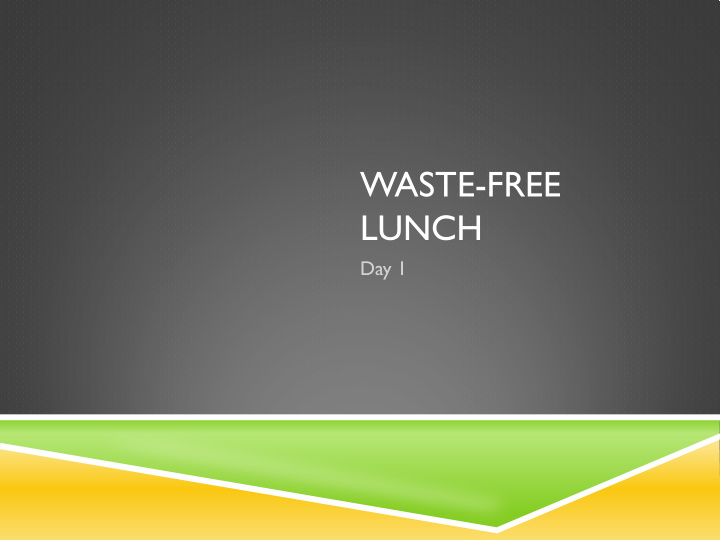



WASTE-FREE LUNCH Day 1
OBJECTIVE Describe how a waste-free lunch at the Olympics could minimize our impact on the environment.
CHALLENGE A waste-free lunch day will occur on Wednesday at our school. How can we advertise this? How would a waste-free lunch at our school influence the environment? How can we reduce, reuse, and recycle in our own lives? What effect would a waste free lunch at the Olympics be?
QUESTION What happens to the environment when non- biodegradable items pollute it?
THE STATS Some pollutants remain in environment for longer time because they decompose very slowly by the natural processes. Plastic bags are used at a rate of about a hundred billion per year in the US alone Over a hundred thousand animals – ranging from sea turtles to albatrosses to camels – die each year from the ingestion of plastic bags. Due to barriers to recycling Styrofoam, due to its ubiquitous presence in disposable packaging, and due to its tendency to drift away on currents of wind and water, Styrofoam has become an abundant form of plastic pollution on land and in waterways
REDUCE AND REUSE Reduction and reuse are the most effective ways you can save natural resources and protect the environment By reusing items, you are reducing the amount of waste that will need to be recycled or sent to landfills and incinerators Reusing items reduces pollution because it reduces the need to harvest new raw materials
HOW TO REDUCE AND REUSE Reduce the amount of products that uses a lot of packaging. Less packaging=less waste Buy reusable over disposable. Example: silverware vs plastic fork Donate items instead of discarding. Reducing waste and allowing others to reuse.
RECYCLE The process of collecting and processing materials that would otherwise be thrown away as trash and turning them into new products Reduces the amount of waste sent to landfills and incinerators Conserves natural resources such as timber, water and minerals
HOW DO YOU RELATE TO THIS? Talk to your tablemates about how you relate to this topic. Choose a spokesperson to summarize to the class what you talked about.
WASTE-FREE LUNCH ADVERTISEMENT Work in groups of 3 to design a poster to advertise the Waste-free lunch day we will have on Wednesday Either use Glogster or notebook paper that you would have normally thrown away to draw your design
SO, WHY DOES THIS EVEN MATTER? Write in your notebooks why it is important for everyone to take part in helping our environment. Describe how a waste-free lunch day at our school could impact the environment. Start a discussion with your group members. Ask each other questions and discuss how you could be waste-free.
HOMEWORK Give letter to parent/guardian. Begin planning what you will bring for lunch on Wednesday. Hint: Think about how you will pack your lunch, too. Bring in at least one item you would normally throw away but instead could be recycled.
WASTE-FREE LUNCH Day 2
OBJECTIVE Describe how a waste-free lunch at the Olympics could minimize our impact on the environment.
CHALLENGE A waste-free lunch day will occur on Wednesday at our school. How can we advertise this? How would a waste-free lunch at our school influence the environment? How can we reduce, reuse, and recycle in our own lives? What effect would a waste free lunch at the Olympics be?
REDUCE, REUSE, AND RECYCLE How can we reduce, re-use, and recycle materials in our everyday lives?
REDUCE, REUSE, AND RECYCLE What are some ways to avoid wasting parts of a lunch? If you get stuck, use the school cafeteria lunches or a fast food restaurant lunch as an example
WHAT ABOUT THE ITEMS AT THE OLYMPICS? Predict the items you think a person at the Olympics will use that they could reduce, reuse, or recycle Example: Soda can
WHAT ABOUT THE ITEMS AT THE OLYMPICS? Predict how many times a person will use those items over the course of 4 days at the Olympics Example: Soda can (6 times)
WHAT ABOUT THE ITEMS IN YOUR OWN LIFE? Write a list of items you come across in your daily life that could be reduced, re-used, or recycled.
HOMEWORK Tally how many times you come across that item between now and tomorrow’s class. Add items you come across that were not previously listed and tally those as well. Bring in at least one item that is reusable/recyclable that you would normally throw away
WASTE-FREE LUNCH Day 3
OBJECTIVE Describe how a waste-free lunch at the Olympics could minimize our impact on the environment.
CHALLENGE A waste-free lunch day will occur on Wednesday at our school. How can we advertise this? How would a waste-free lunch at our school influence the environment? How can we reduce, reuse, and recycle in our own lives? What effect would a waste free lunch at the Olympics be?
GROUP WORK & DATA COLLECTION In groups of 5, discuss how you packed your waste- free lunch. Identify the intentional choices you made. Record all the items and tallies you found for homework on Google Sheets. Decide which items were tallied the most.
OLYMPICS Make a prediction about whether you think this item will be the most used item at the Olympics. Write down ways you could influence people at the Olympics to reduce, reuse, or recycle items.
1 PAGE REFLECTION Things to write about: Your reaction to what you learned How you plan to apply what you have learned Why it would be important if our school was waste-free What the impact would be if the 2018 Olympics was waste-free
Recommend
More recommend